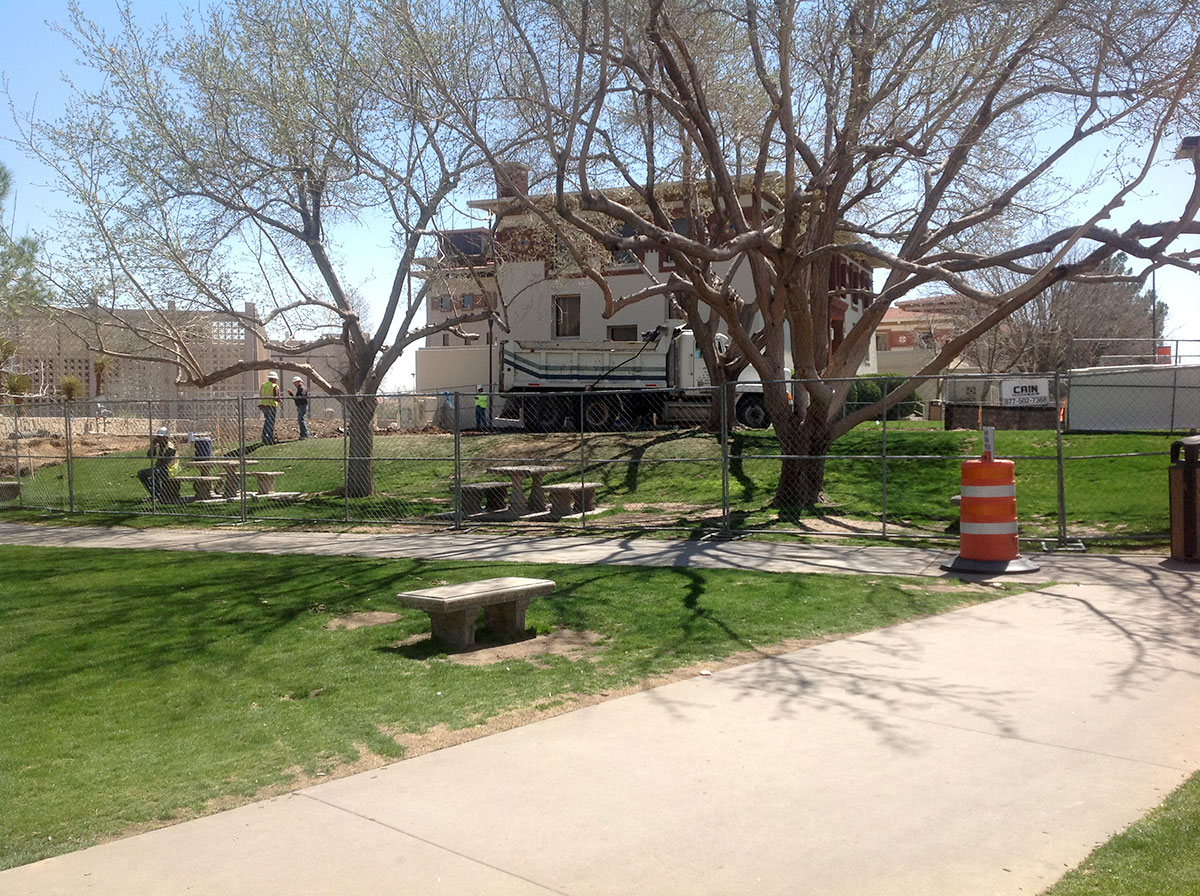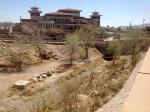
Arroyos like the one at UTEP are home to a wide variety of vegetation and wildlife such as the Yucca plants and skunks. (Paul Reynoso/Borderzine.com)
EL PASO — Major changes are well under way at the University of Texas El Paso as the campus two-year pedestrian and environmental friendly transformation project takes shape. The landscape of the campus features an arroyo that runs primarily from the northeast side of campus near Miner Village down to the southwestern side by the Business Administration Building. This arroyo will be one of the focus points of change during the project.

An artist's rendering that highlights UTEP’s arroyo project that will help encourage outdoor activity on campus. (Paul Reynoso/Borderzine.com)
The project falls under UTEP’s master plan to dramatically improve the campus for the UTEP community and the students. There are seven segments of the transformation project such as pedestrian friendly pathways and additional green spaces. According to the master plan the changes are meant to help create an environment that is consistent with a tier-one university. UTEP officials said that the total cost of the transformation is expected to be around $25 million with a portion coming through fundraising efforts for UTEP’s centennial campaign.
One of the aspects of the project will include building new and smaller arroyos throughout campus that will help clean and lead storm water into the arroyo which cuts into campus including underneath Hawthorne Street and the Liberal Arts building.
The arroyo aspect of the campus transformation project will also depend on fundraising efforts through UTEP’s Campus Transformation Fund (CTF) that allows University stakeholders to permanently invest in UTEP. With the funding, the main arroyo from Miner Village down to University Ave. could expect some changes, according to Greg McNicol, associate vice president of Business Affairs at UTEP.

The arroyo passes underneath the Liberal Arts building before crossing under Hawthorn Street. (Paul Reynoso/Borderzine.com)
McNicol said that the plan is to include putting check dams at the bottom of the arroyo. “What that does is slow the water down,” McNicol said. “It also helps take out some of the sediment including large rubble which will build up behind the check dam and that’s exactly what you want it to do.”
There are also plans to include pedestrian and bike pathways on the banks of the arroyo to encourage outdoor activity like walking and bicycling within the UTEP Campus, according to McNicol. He added that the ultimate goal is to make the bike trail a unique experience for cyclists and students to get to school.
“I’m working with the city of El Paso to try and tie the bike and pedestrian trail all the way to the Palisades,” McNicol said. He explained that Palisades is a park at the bottom of the Franklin Mountains owned by the El Paso Water utilities.
In addition to the plans to build check dams and pedestrian/bike trails along the arroyo, McNicol said that a purple-pipe system is also in the works. Its purpose is to help deliver recycled water that will comes from micro-processed wastewater at UTEP, and will allow El Paso water utilities to use it for industrial and irrigation purposes around the city.
The incorporation of the purple-pipe system would have a positive effect on areas like the arroyos, according to Carlos Ramirez, manager of the El Paso Water Utilities Reclaimed Water.
With El Paso receiving well below average rainfall in the past several years and undergoing a severe drought, Ramirez said that arroyos like the one at UTEP stand to benefit from the project.
“The biggest contribution to the environment is that it will be saving water,” he said. “With the drought in El Paso, this is really a big part of it.”
Ramirez said that UTEP’s inclusion of the arroyo in the project could encourage other parks and facilities in the city to use reclaimed water. “It’s cheaper and we don’t tax our political water supply as much.”
With the expected changes coming to the campus and the arroyo, the focus will be on the environmental impacts that the changes might have on the eco-system of the natural arroyo.
John Sproul, program coordinator and manager of El Paso’s Bosque Wetlands Park, said any significant impact on the arroyo’s eco-system depends on the amount of changes the arroyo goes through.
“The aspect of it is how it’s going to change the vegetation of the arroyo,” Sproul said. “If it’s done with minimal disturbance, that’s one thing. But if they do it in a way that takes out a lot of vegetation, that’s another thing.”
Sproul said arroyos like the one at UTEP and around El Paso can house various types of wildlife such as the grey fox and the hog-nosed skunks. He also said that this type of wildlife would be affected by sudden environmental changes such as human interaction.
“If you have an area that sees relatively little human activity right now and you suddenly put a whole lot of people in there, you’re going to change the attractiveness of the area to the wildlife that does live there,” Sproul said.

Construction has already begun on UTEP’s transformation project as part of the school’s Master Plan. (Paul Reynoso/Borderzine.com)
He also pointed out that the campus transformation project is a wait and see process. It would take some time to see if there are any long-term effects on the arroyo’s eco-system due to the changes coming.
Currently work has already begun on the campus transformation project, including Wiggins Road, where pedestrian pathways and green spaces will replace the current road between the campus library and the Health Sciences and nursing building .Work will also soon follow on the centennial plaza segment of the project which is expected to begin in May.
For UTEP students, the prospect of having a more pedestrian and environmental friendly campus is promising. “I think it’s better for UTEP and it will attract more people,” said Cortez Harris, a Freshman Criminal Justice major.
Cortez said he likes the idea of having more options to get around campus. “It’s better for people to ride around, walk around, and just be safer.”
Art Diaz, Marketing and Management professor at UTEP, said the changes to the arroyo and campus will have a positive effect for both students and faculty. “It’s good, it’s a different sight” said Diaz.
For Diaz, this project could not have come at a better time as UTEP has seen an increase in its student population in recent years. “I’ve known about the university since about the age of six and I have seen it grow tremendously and I think nothing but more growth is going to occur.”
The completion date for the transformation project is expected to be late 2014, which will be in conjunction with the school’s centennial celebration.
- The arroyo passes underneath the Liberal Arts building before crossing under Hawthorn Street. (Paul Reynoso/Borderzine.com)
- An artist’s rendering shows the proposed changes that the school’s arroyo could expect. (Paul Reynoso/Borderzine.com)
- Construction has already begun on UTEP’s transformation project as part of the school’s Master Plan. (Paul Reynoso/Borderzine.com)
- Arroyos are prone to flash flooding during El Paso’s monsoon season. (Paul Reynoso/Borderzine.com)
- Arroyos like the one at UTEP are home to a wide variety of vegetation and wildlife such as the Yucca plants and skunks. (Paul Reynoso/Borderzine.com)
- Wildlife at the arroyo might be affected by sudden environmental changes such as human interaction. (Paul Reynoso/Borderzine.com)
- The plan for the arroyo includes putting check dams to slow the water down and to take out some of the sediment. (Paul Reynoso/Borderzine.com)









